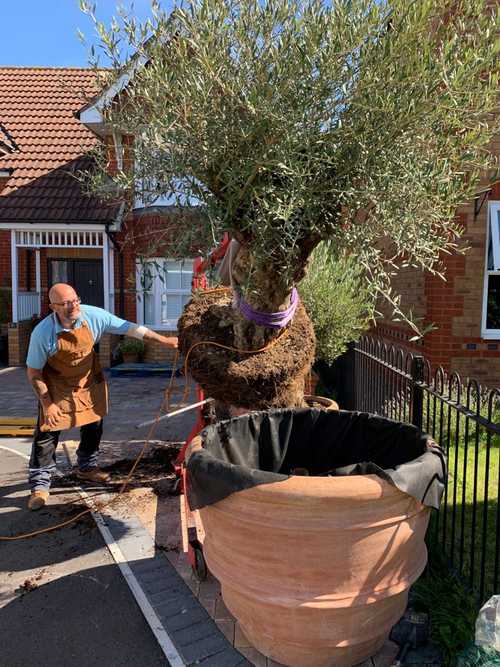Planting an Olive Tree

One of the most popular reasons for purchasing one of our handmade Italian terracotta pots is an olive tree display. Olives suit container planting particularly well, they cope well with having their roots constrained, and a beautiful terracotta planter is hard to beat for a delightful, finished look.
This blog will share some top tips and recommendations for olive tree display and planting, helping to achieve a stunning addition to any garden, big or small.
Choosing the terracotta pot.
Of course, you can plant a tree in most of our pot styles; however, some lend themselves to olive trees better than others. You will need to think big for the vast, ancient olive trees; there is nothing worse for stability and aesthetics than trying to cram a large tree into a small pot!
If you are to invest in a large planter, buy the best you can afford as they will be around for some time. Buying a cheaper pot may seem tempting, but if the quality isn't up to scratch, you will only end up having to replace it after the first harsh frost! Also worth considering carefully is the pot's style; choose one that you know you will enjoy looking at for years to come and, if possible, position it in its 'forever home'. It's relatively easy to change what's planted in a large pot but not so easy to move them!
Popular customer choices for olive trees with broad crowns are Cilindro Grande, Bassa Liscia, Bassa Festone, and Vaso Imprunetino. These styles are reasonably low and with wide, stable bases. The Conca Siena is a solid choice for taller olive trees and, with its wide belly shape, gives a good amount of planting area. Whichever you choose, you should allow room for root growth. As a guide, a tree in a nursery pot measuring 60cm internal diameter and 48cm high would need to step up to a terracotta pot 80cm internal diameter and 58cm tall. We are always happy to advise on this to help you decide and encourage you to pick up the phone for a chat.
Proper planning.
Like most projects, planting a large tree into a terracotta pot is easier if you have planned ahead. Below are items you will need and areas to consider before you start:
- Drainage medium. Use terracotta crocks, pea gravel or a mix of both.
- Geotextile. Not essential but often used for lining the pot and containing the compost, which will aid drainage and give additional protection. We supply this free with every pot purchase.
- Compost. John Innes No3 is best for a mature tree. We can advise on how many litres you will need for your chosen pot.
- Horticultural grit. Essential to add to the compost to aid drainage. You will need about 20% grit of the compost volume.
- Decorative topping. As well as looking good, this also has a practical function as it slows down the water evaporation in very hot weather.
- Position. Take time to select a suitable place for the pot and tree. Contained olives will want a sunny position, with some shelter from North and Easterly cold winds.
Planting the tree.
We appreciate that there are different ways to achieve the same goal, but please look at our general advice on the planting process for more information. In addition to this advice, you should also make sure you have enough people to assist and proper lifting equipment if needed. For example, if you have a very large tree and are using a mechanical aid, firstly, check the tree's weight so you know you have the correct lift capacity.
We recommend that the planting is carried out with the terracotta pot upright, placed on either pot feet or risers and in its final position. To keep the pot safe from damage (and more importantly, yourself!), the tree should be manoeuvred into the pot under control, don't let gravity take over!
Top tips.
- If possible, don't water the tree just before you plan to pot it; let the rootball dry out a little to reduce the weight.
- After removing the tree from its nursery pot, scrape away some of the compost from around the rootball. Doing so has several benefits; it reduces the weight a little more, releases the roots and gets rid of old, possibly sour compost. We find a three-pronged handheld garden cultivator does the job well.
- When planting larger trees, don't use thin terracotta crocks around the drain hole as the tree's weight could flatten them over the hole, blocking it. Instead, consider using mixed size gravel in a level layer across the bottom of the pot.
Ongoing pot and tree care.
Our terracotta pots are very durable and well able to cope outside in all weathers, but it's essential to check and ensure free drainage regularly.
It is a myth that olives in containers are drought hardy. As with most potted plants, they need regular water and feed to thrive. Even during wet weather, not enough rain will get into the pot to sustain the tree. Moist, free-draining soil is ideal; don't let the compost dry out totally before watering. Remember to water right through the pot until you can see it emerging from the pot's drain hole; this proves the drainage is clear too.
During the growing season, roughly April/May to October, regularly apply tomato food such as Tomorite, following the makers' instructions.
After all that hard work, remember to sit back, relax and enjoy the small piece of Italy in your garden.
Posted by Lorrayne Scott-Collins on January 19th 2021
